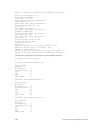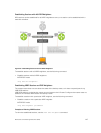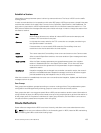
The following example shows viewing sessions with VRRP neighbors. The bold line shows that VRRP BFD
sessions are enabled.
R1(conf-if-te-4/25)#vrrp bfd all-neighbors
R1(conf-if-te-4/25)#do show bfd neighbor
* - Active session role
Ad Dn - Admin Down
C - CLI
I - ISIS
O - OSPF
R - Static Route (RTM)
V - VRRP
LocalAddr RemoteAddr Interface State Rx-int Tx-int Mult Clients
* 2.2.5.1 2.2.5.2 Te 4/25 Down 1000 1000 3 V
To view session state information, use the show vrrp command.
The following example shows viewing VRRP session state information. The bold line shows the VRRP BFD
session.
R1(conf-if-te-4/25)#do show vrrp
------------------
TenGigabitEthernet 4/1, VRID: 1, Net: 2.2.5.1
State: Backup, Priority: 1, Master: 2.2.5.2
Hold Down: 0 sec, Preempt: TRUE, AdvInt: 1 sec
Adv rcvd: 95, Bad pkts rcvd: 0, Adv sent: 933, Gratuitous ARP sent: 3
Virtual MAC address:
00:00:5e:00:01:01
Virtual IP address:
2.2.5.4
Authentication: (none)
BFD Neighbors:
RemoteAddr State
2.2.5.2 Up
Changing VRRP Session Parameters
BFD sessions are configured with default intervals and a default role.
The parameters that you can configure are: Desired TX Interval, Required Min RX Interval, Detection
Multiplier, and system role. You can change parameters for all VRRP sessions or for a particular neighbor.
To change parameters for all VRRP sessions or for a particular VRRP session, use the following
commands.
• Change parameters for all VRRP sessions.
INTERFACE mode
vrrp bfd all-neighbors interval milliseconds min_rx milliseconds multiplier
value role [active | passive]
• Change parameters for a particular VRRP session.
INTERFACE mode
vrrp bfd neighbor ip-address interval milliseconds min_rx milliseconds
multiplier value role [active | passive]
To view session parameters, use the show bfd neighbors detail command, as shown in the
example in
Verifying BFD Sessions with BGP Neighbors Using the show bfd neighbors command
example in Displaying BFD for BGP Information.
148
Bidirectional Forwarding Detection (BFD)


















